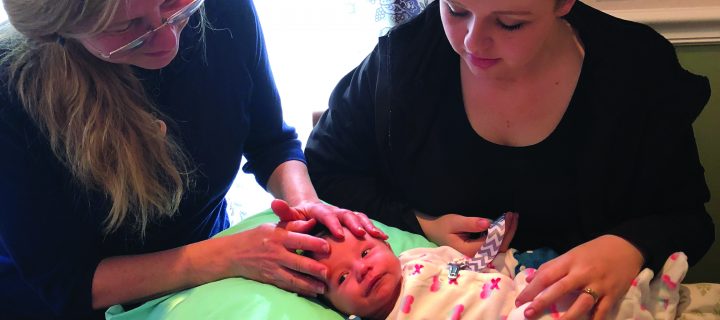Does your baby have breastfeeding issues like
trouble latching, flailing, or vomiting?
Do you have an infant that cries even though
you have fed and changed them?
These are common challenges for parents, so it is understandable that, according to the Center for Disease Control, only 55% of babies are nursed for the recommended six-months or more. CranioSacral Therapy (CST) is a gentle and effective treatment that helps babies nurse, digest, sleep, and move with greater ease. Here are a few recent stories from my CranioSacral Therapy practice in Chico. Names are changed for privacy.
Support for Nursing
Dylan had a shallow latch on the breast and was not getting enough milk. In the middle of feeding, he would break off and cry. He was losing weight and his mother, Autumn, was worried and frustrated.
When we started the session, Dylan was crying loudly, so his mother cradled him on a pillow on her lap. I quieted my mind before I placed my hands on his body. As my fingers felt the subtle movement of the cerebral spinal fluid, he slowly relaxed and the upset calmed. I felt tension in the temporal and mandible bones that form the jaw. These bones allow the nursing baby to suck efficiently and if they are restricted, the baby cannot open its mouth wide enough to make a deep latch.
With some gentle techniques, using no more than 1 gram of pressure, the jaw released. Both mother and child softened and stilled. The next day, Autumn called to say that Dylan nursed more comfortably after the session, and that he slept for a longer period during the night.
Overcoming Trauma
Mia was whisked away from her mother, Jess, within minutes after birth and flown to Davis for surgery. The procedure was successful, but afterward the baby cried often, holding her little body tightly, as if she expected another emergency helicopter ride. After six CST sessions, she transformed into a relaxed infant. One of the sessions was for Jess, because she was also traumatized by their early separation. Caregivers and babies are so closely connected that the baby easily feels their stress.
In Jess’s CST session we added therapeutic dialogue and imagery to create the ideal birth she had wanted. She visualized her baby being delivered smoothly and placed immediately in her arms. She felt her baby’s skin against her own as they lay together in a calm birthing room, their bond deepening. Imagination has the power to trigger the release of chemicals and hormones. After the session, Jess reported a weight had been lifted and she felt more joyful.
What is CranioSacral Therapy (CST)?
CST is a light touch modality that was developed from osteopathy in the 1970s by Dr. John Upledger. With a team of scientists at Michigan State University, Dr. Upledger proved the existence of the craniosacral system and created a therapy to enhance its function. He discovered it had numerous health benefits for people of all ages, from easing headaches, back pain and PTSD, to relieving depression and autism. I was fortunate to study directly with Dr. Upledger, and to be a teaching assistant for him before he passed in 2012. He was passionate about supporting newborns with CST to give them the healthiest start and to avoid future complications.
Infant Cranial Bones
The bones in a baby’s head are not fully formed. There are soft spots called fontanelles, and the cranial bones are in several pieces. This allows the cranial bones to overlap in the birth canal for an easier passage, and to expand afterward as the brain grows.
Problems may occur if the birthing process requires the doctor to pull or twist the baby’s neck, or to intervene with forceps or vacuum traction. Pitocin, a medication used to induce labor, causes very strong contractions. A C-section birth may create an abrupt pressure change for baby’s delicate tissues. These actions may be necessary, but can contribute to restrictions in the infant’s cranial bones. This, in turn, impedes the movement of the cerebral spinal fluid, and may impinge the cranial nerves emerging from the base of the skull.
Feeling the Flow
The cranial bones widen and narrow to accommodate the production and re-absorption of the cerebral spinal fluid. I can palpate the movement of these fluids and it tells me the location of restrictions. I never force a release. Instead, I hold the area with intention, recognizing the infant’s inner wisdom that naturally moves towards balance. After waiting patiently, a release happens with a sigh, a softening, an opening and a lengthening.
Conclusion
CST is considered complimentary to medical care. I suggest parents visit their pediatricians and lactation consultants for diagnoses and guidance. I am thrilled to do my part to support a baby’s first weeks on the planet, and to help parents have peace at home.
By Anasuya Basil, NC, Dipl. ABT, CST, www.mybodywisdom.net





